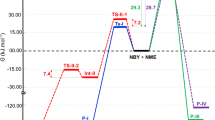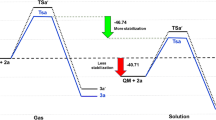Abstract
Quantum chemical calculations were used to investigate the Diels-Alder reactivities for a series of cycloalkenediones with tetrazine. We find that the reactivity trend of cycloalkenediones toward tetrazine is opposite to cycloalkenes. The electrostatic interactions between the cycloalkenediones and tetrazine become more stabilizing as the ring size of the cycloalkenediones increases, resulting in lower activation energies. The origin of the more favorable electrostatic interactions and the accelerated reactivities of larger cycloalkenediones result from a stabilizing CH/π interaction that is not present in the reaction of the 4-membered cycloalkenedione. The Diels-Alder reactivity trend of cycloalkenediones toward tetrazine is opposite that of cycloalkenes. The increased reactivity of the 5- and 6-membered cycloalkenediones relative to the 4-membered cycloalkenedione is attributed to a stabilizing electrostatic CH/π interaction that is not present in the reaction of the 4-membered cycloalkenedione.

The Diels-Alder reactivity trend of cycloalkenediones towards tetrazine is opposite of cycloalkenes. The increased reactivity of the 5- and 6-membered cycloalkenediones relative to the 4-membered cycloalkenedione is attributed to a stabilizing electrostatic CH/π interaction that is not present in the reaction of the 4-membered cycloalkenedione








Similar content being viewed by others
References
Paton RS, Kim S, Ross AG et al (2011) Experimental Diels-Alder reactivities of cycloalkenones and cyclic dienes explained through transition-state distortion energies. Angew Chem Int Ed 50:10366–10368
Belluš D, Ernst B (1988) Cyclobutanones and cyclobutenones in nature and in synthesis [new synthetic methods(71)]. Angew Chem Int Ed Engl 27:797–827
Li X, Danishefsky SJ (2010) Cyclobutenone as a highly reactive dienophile: expanding upon Diels-Alder paradigms. J Am Chem Soc 132:11004–11005
Liu F, Paton RS, Kim S et al (2013) Diels-Alder reactivities of strained and unstrained cycloalkenes with normal and inverse-electron-demand dienes: activation barriers and distortion/interaction analysis. J Am Chem Soc 135:15642–15649
Sauer J, Heldmann DK, Hetzenegger J et al (1998) 1,2,4,5-Tetrazine: synthesis and reactivity in [4 2] cycloadditions. Eur J Org Chem 2885–2896
Levandowski BJ, Hamlin TA, Bickelhaupt FM, Houk KN (2017) Role of orbital interactions and activation strain (distortion energies) on Reactivities in the normal and inverse electron-demand cycloadditions of strained and unstrained cycloalkenes. J Org Chem 82:8668–8675
Levandowski BJ, Hamlin TA, Helgeson RC et al (2018) Origins of the endo and exo selectivities in cyclopropenone, iminocyclopropene, and triafulvene Diels-Alder cycloadditions. J Org Chem 83:3164–3170
Zhao Y, Truhlar DG (2008) The M06 suite of density functionals for main group thermochemistry, thermochemical kinetics, noncovalent interactions, excited states, and transition elements: two new functionals and systematic testing of four M06-class functionals and 12 other functionals. Theor Chem Accounts 120:215–241
Frisch MJ, Trucks GW, Schlegel HB et al (2009) Gaussian 09, revision D.01. Gaussian, Inc., Wallingford
Bickelhaupt FM, Houk KN (2017) Analyzing reaction rates with the distortion/interaction-activation strain model. Angew Chem Int Ed 56:10070–10086
te Velde G, Bickelhaupt FM, Baerends EJ et al (2001) Chemistry with ADF. J Comput Chem 22:931–967
Fonseca Guerra C, Snijders JG, te Velde G, Baerends EJ (1998) Towards an order-N DFT method. Theor Chem Accounts 99:391–403
ADF (2017) SCM theoretical chemistry. Vrije Universiteit, Amsterdam. https://www.scm.com/
van Lenthe E, Baerends EJ (2003) Optimized Slater-type basis sets for the elements 1-118. J Comput Chem 24:1142–1156
Franchini M, Philipsen PHT, van Lenthe E, Visscher L (2014) Accurate coulomb potentials for periodic and molecular systems through density fitting. J Chem Theory Comput 10:1994–2004
Wheeler SE, Houk KN (2009) Through-space effects of Substituents dominate molecular electrostatic potentials of substituted Arenes. J. Chem. Theory Comput. 5:2301–2312
Politzer P, Truhlar DG (2013) Chemical applications of atomic and molecular electrostatic potentials: reactivity, structure, scattering, and energetics of organic, inorganic, and biological systems. Springer, New York
Hamlin TA, Hamann CS, Tantillo DJ (2015) Delocalization of charge and electron density in the humulyl cation—implications for terpene biosynthesis. J Org Chem 80:4046–4053
Levandowski BJ, Houk KN (2016) Hyperconjugative, secondary orbital, electrostatic, and steric effects on the reactivities and endo and exo stereoselectivities of cyclopropene Diels-Alder reactions. J Am Chem Soc 138:16731–16736
Nishio M, Umezawa Y, Honda K et al (2009) CH/π hydrogen bonds in organic and organometallic chemistry. CrystEngComm 11:1757
Nishio M, Umezawa Y, Fantini J et al (2014) CH–π hydrogen bonds in biological macromolecules. Phys Chem Chem Phys 16:12648–12683
Nishio M (2011) The CH/π hydrogen bond in chemistry. Conformation, supramolecules, optical resolution and interactions involving carbohydrates. Phys Chem Chem Phys 13:13873–13900
Acknowledgments
We thank the National Science Foundation (NSF CHE-1361104), the National Institute of Health (NIH R01GM109078), and the Netherlands Organization for Scientific Research (NWO) for financial support. We thank Dennis Svatunek for helpful discussions and assistance in generating the ESP maps. Computer time was provided by the UCLA Institute for Digital Research and Education (IDRE) on the Hoffman2 supercomputer. We additionally thank SURFsara for use of the Cartesius supercomputer.
Author information
Authors and Affiliations
Corresponding authors
Additional information
Dedication: Dedicated to Tim Clark, computational chemist and friend, on the occasion of his 70th birthday.
Publisher’s note
Springer Nature remains neutral with regard to jurisdictional claims in published maps and institutional affiliations.
This paper belongs to the Topical Collection Tim Clark 70th Birthday Festschrift
Electronic supplementary material
ESM 1
(DOCX 370 kb)
Rights and permissions
About this article
Cite this article
Levandowski, B.J., Hamlin, T.A., Eckvahl, H.J. et al. Diels-Alder reactivities of cycloalkenediones with tetrazine. J Mol Model 25, 33 (2019). https://doi.org/10.1007/s00894-018-3909-z
Received:
Accepted:
Published:
DOI: https://doi.org/10.1007/s00894-018-3909-z




